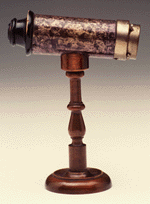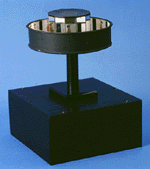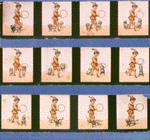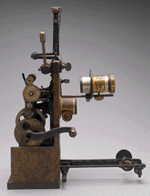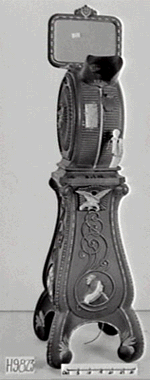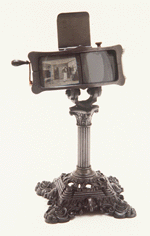Moving pictures - The pre-history of cinema
from the collection of the Powerhouse Museum, Sydney | |||||||||
What do you expect when you sit down to watch a film in a movie theatre? These days, you are most likely to be in a large audience, all experiencing digital surround-sound and colour moving pictures on a wide screen. The images you see and sounds you hear are the culmination of many hundreds of years of study and invention by people in different countries in a variety of fields. In the early 1800’s, a scientist called Roget wrote an essay which explored the subject of persistence of vision. This was an idea that people had been thinking about for a long time, but Roget’s essay excited and stimulated many scientists to start experimenting and designing devices which demonstrated the persistence of vision. This experimentation would eventually lead to the development of motion pictures. Have you ever wondered why the world doesn’t go black each time you blink? The reason is the persistence of vision. Your brain momentarily holds images even after what you observed has been physically obscured. When you watch a film in a movie theatre, you do not really see a moving picture. You see 24 different still images per second. These are called frames, and you do not perceive the black space that separates the frames. Instead, your brain blends the images into each other to make a moving image. Other important fields of investigation were involved in the development of motion picture machines. These include the study of motion, the science of optics and lens making, the development of photography, the refinement of techniques for projecting images, developments in sound recording and the inventions of new materials like celluloid. Examples of machines which demonstrate the persistence of vision include the Phenakistiscope, the Zoetrope, the Kineograph, the Praxinoscope, the Zoöpraxiscope and the Thaumatrope. (Try reading all these aloud!) These optical devices were designed for scientific investigation, but they were also very popular with the general public and found great success as home entertainment and parlour games. The same principles are at work in all these devices. The illusion of a moving picture is produced by a set number of images played over and over in a loop. In order for the loop to appear seamless the last image should resolve into or introduce the first image. For example, if you walk up the street you will notice that your body will get into a rhythm that is repeated, step by step. If we made a series of 24 snapshots of you walking just two steps, we could then make the images into a loop. When this loop is played, we would get the impression of watching you walking in continuous motion even though we are actually seeing you take the same two steps over and over. Experiments by another inventor in the late 1880s led to the development of the Kinetograph, which captured images continuously using a new material called celluloid or film - a flexible material in continuous lengths that accepted photosensitive chemicals. The processed film was then displayed in a machine called a Kinetoscope. They were very popular and found their way into amusement parlours across the United States of America. There were other machines that imitated the Kinetoscope. One of these was called the Mutoscope or Kinora, which displayed a series of printed photographs in a flipbook fashion. One problem with all these machines was that they demonstrated motion pictures to just one person at a time! It took more work to perfect a technique for projecting film in a darkened room, which could be viewed by a group of people. This was to be the defining moment in the history of motion pictures - a remarkable feat achieved by the Lumiere brothers in France, in 1895. The Lumiere brothers had closely studied the Kinetoscope and by 1895 they designed and built their Cinematographe. The Cinematographe had many features which made it more advanced than the Kinetoscope, including a slower frame rate of 16 per second - a big improvement on the Kinetoscope’s 48 frames (or images) per second. The Cinematographe was also very light and portable, which allowed the Lumiere brother to venture outdoors and film real events - the first time this had ever occurred. Most importantly, it had a projecting light source so the film could be projected across a room onto a screen, showing the recorded events larger than life-size. This was something that astounded the world - the first true movie theatre. By 1900 the popularity of film was generating enough income to support a growing community of filmmakers, camera and projector designers and manufacturers, actors, writers, directors and other workers who all cooperate to make the production of films possible. Campbell Bickerstaff, Assistant Curator, Information Technology, Powerhouse Museum.
|
| ||||||||

